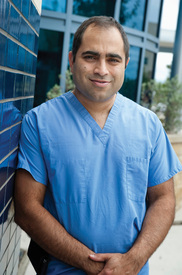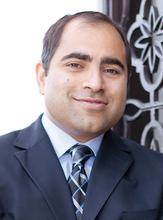
Dr. Joseph Diaz shares his story about treating his prostate cancer through the help of renowned robotic urologic surgeon, Dr. Naveen Kella.
It is a daunting statistic, but according to the American Cancer Society, one out of every six men in the United States will be diagnosed with prostate cancer. Fortunately, robotic urologic surgeon Dr. Naveen Kella is posting some remarkable statistics of his own.
With more than 2,000 robotic urologic surgeries under his surgeon’s cap, Kella is the most experienced robotic surgeon in the region, as well as one of the top surgeons in the nation, having performed live cases for national urologic conferences and training urologists nationwide
It is a daunting statistic, but according to the American Cancer Society, one out of every six men in the United States will be diagnosed with prostate cancer. Fortunately, robotic urologic surgeon Dr. Naveen Kella is posting some remarkable statistics of his own.
With more than 2,000 robotic urologic surgeries under his surgeon’s cap, Kella is the most experienced robotic surgeon in the region, as well as one of the top surgeons in the nation, having performed live cases for national urologic conferences and training urologists nationwide
San Antonio men now have access to a urology program boasting the most experienced physicians in the state, as Kella recently introduced the Urology and Prostate Institute (UPI). UPI is the region’s first private practice to provide general urology in conjunction with a comprehensive medical, radiation and urologic oncology program.
Knowing that experience is paramount when it comes to his field of robotic surgery, Kella is comfortable performing six to 10 prostatectomies per week. He is recognized as a Texas Super Doctor, but more importantly, he is known as a super doctor to his patients, who happen to include other physicians in San Antonio.
As a surgeon, gaining the trust to perform surgery on a fellow physician can prove to be a delicate duty. Nonetheless, local physicians such as allergy, asthma and immunology specialist Dr. Joseph Diaz have confided in Kella’s skill in robotic surgery.
Diaz was diagnosed with prostate cancer and had his prostatectomy performed by Kella in March. Five months later, as a thriving survivor, Diaz summited Mount Kilimanjaro – the highest mountain in Africa – and is en route to compete in the prestigious Boston Marathon in April 2013.
“I had a fabulous recovery,” Diaz said. “It was extremely difficult after surgery because I do not like pain; [but] I have had great recovery in erectile function and without incontinence, which were the two big things that were worrisome to me.”
Kella is honored each time a man elects for him to perform his surgery; but as a doctor treating a doctor in this case, this time he was humbled.
“It is a very humbling feeling when another physician believes you are the best person to do his procedure,” Kella said. “As a doctor, I know that I would do my research to not only find the best doctor for my condition, but also find someone that I feel personally cares about me. I am honored that Dr. Diaz did that same research and placed his trust in me to perform his surgery.”
“I was absolutely comfortable with Dr. Kella’s experience with robotic surgery and his reputation in the community,” Diaz said. “Especially once I sat down with him; I had that immediate reassurance that I needed.”
Diaz has suggested Kella to other men who are going through what he experienced just a short time ago, and he makes sure to tell it exactly how it is.
“I told them they were not alone,” Diaz said. “I also told them that I absolutely think that the best person in town is Dr. Kella because he is local and you are close to your family and your friends, so it makes recovery easier. Staying local is important because you do not have to go to meccas such as MD Anderson or Mayo Clinic when there is the same level of expert care here by a surgeon who is more experienced.
“I tell people that Dr. Kella always followed up on my questions, and he even has a great bedside manner. In retrospect, I made the absolute right choice.”
To give more information to his current and prospective patients, Dr. Naveen Kella maintains a blog at www.texasroboticsurgery.com.
Knowing that experience is paramount when it comes to his field of robotic surgery, Kella is comfortable performing six to 10 prostatectomies per week. He is recognized as a Texas Super Doctor, but more importantly, he is known as a super doctor to his patients, who happen to include other physicians in San Antonio.
As a surgeon, gaining the trust to perform surgery on a fellow physician can prove to be a delicate duty. Nonetheless, local physicians such as allergy, asthma and immunology specialist Dr. Joseph Diaz have confided in Kella’s skill in robotic surgery.
Diaz was diagnosed with prostate cancer and had his prostatectomy performed by Kella in March. Five months later, as a thriving survivor, Diaz summited Mount Kilimanjaro – the highest mountain in Africa – and is en route to compete in the prestigious Boston Marathon in April 2013.
“I had a fabulous recovery,” Diaz said. “It was extremely difficult after surgery because I do not like pain; [but] I have had great recovery in erectile function and without incontinence, which were the two big things that were worrisome to me.”
Kella is honored each time a man elects for him to perform his surgery; but as a doctor treating a doctor in this case, this time he was humbled.
“It is a very humbling feeling when another physician believes you are the best person to do his procedure,” Kella said. “As a doctor, I know that I would do my research to not only find the best doctor for my condition, but also find someone that I feel personally cares about me. I am honored that Dr. Diaz did that same research and placed his trust in me to perform his surgery.”
“I was absolutely comfortable with Dr. Kella’s experience with robotic surgery and his reputation in the community,” Diaz said. “Especially once I sat down with him; I had that immediate reassurance that I needed.”
Diaz has suggested Kella to other men who are going through what he experienced just a short time ago, and he makes sure to tell it exactly how it is.
“I told them they were not alone,” Diaz said. “I also told them that I absolutely think that the best person in town is Dr. Kella because he is local and you are close to your family and your friends, so it makes recovery easier. Staying local is important because you do not have to go to meccas such as MD Anderson or Mayo Clinic when there is the same level of expert care here by a surgeon who is more experienced.
“I tell people that Dr. Kella always followed up on my questions, and he even has a great bedside manner. In retrospect, I made the absolute right choice.”
To give more information to his current and prospective patients, Dr. Naveen Kella maintains a blog at www.texasroboticsurgery.com.


 RSS Feed
RSS Feed
